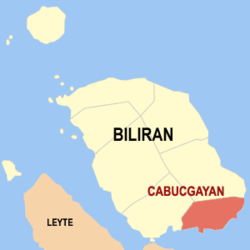Cabucgayan, Biliran
| Cabucgayan | |
|---|---|
| Municipality | |
 Map of Biliran showing the location of Cabucgayan | |
.svg.png) Cabucgayan Location within the Philippines | |
| Coordinates: 11°28′N 124°34′E / 11.47°N 124.57°ECoordinates: 11°28′N 124°34′E / 11.47°N 124.57°E | |
| Country |
|
| Region | Eastern Visayas (Region VIII) |
| Province | Biliran |
| District | Lone district |
| Founded | September 29, 1949 |
| Barangays | 13 |
| Government[1] | |
| • Mayor | Gemma G. Adobo |
| Area[2] | |
| • Total | 54.19 km2 (20.92 sq mi) |
| Population (2015 census)[3] | |
| • Total | 20,788 |
| • Density | 380/km2 (990/sq mi) |
| Time zone | PST (UTC+8) |
| ZIP code | 6550 |
| IDD : area code | +63 (0)53 |
| Income class | 5th class |
| Website |
www |
Cabucgayan is a municipality in the province of Biliran, Philippines. According to the 2015 census, it has a population of 20,788 people.[3]
Cabucgayan derived its name from the snail called "bukgay." In the Waray-Waray language, to make a singular noun into a plural noun, the article "ka" is added before the word and the article "an" after the word. Kabukgayan, therefore, means a place where there are many snails.
This municipality was created on September 29, 1949 when President Elpidio Quirino issued Executive Order no. 271.
It is located in the south-eastern part of Biliran Island, and is approximately 19 kilometres (12 mi) south from Caibiran, 33 kilometres (21 mi) away from Naval, the capital town of the province, and 118 kilometres (73 mi) away from Tacloban City, the capital of the Province of Leyte. It is bound on the north by the Municipality of Caibiran, on the east by Villareal Bay, on the south by Carigara bay, and the west by the Municipality of Biliran
It belongs to the two types of climate, Type II and Type IV. It is characterized by pronounced rainfall periodically accompanied by trade winds and storms during the months of January, June, July, November and December while the minimum monthly rainfall occurs in February, March, April and May.
The total land area dedicated to agriculture is 2,905 hectares (7,180 acres) or 59.63% of the total land area. The three major forest products are timber, rattan and wild abaca.
Barangays
Cabucgayan is politically subdivided into 13 barangays.[2]
- Balaquid
- Baso
- Bunga
- Caanibongan
- Casiawan
- Esperanza (Pob.)
- Langgao
- Libertad
- Looc
- Magbangon (Pob.)
- Pawikan
- Salawad
- Talibong
Demographics
| Population census of Cabucgayan | ||
|---|---|---|
| Year | Pop. | ±% p.a. |
| 1990 | 15,240 | — |
| 1995 | 16,498 | +1.50% |
| 2000 | 17,691 | +1.51% |
| 2007 | 18,799 | +0.84% |
| 2010 | 19,621 | +1.57% |
| 2015 | 20,788 | +1.11% |
| Source: Philippine Statistics Authority[3][4][5] | ||
The population of Cabucgayan in the 2015 census was 20,788 people,[3] with a density of 380 inhabitants per square kilometre or 980 inhabitants per square mile.
References
- ↑ "Municipalities". Quezon City, Philippines: Department of the Interior and Local Government. Archived from the original on 25 January 2013. Retrieved 29 January 2013.
- 1 2 "Province: Biliran". PSGC Interactive. Makati City, Philippines: National Statistical Coordination Board. Archived from the original on 14 November 2012. Retrieved 29 January 2013.
- 1 2 3 4 "Region VIII (EASTERN VISAYAS)". Census of Population (2015): Total Population by Province, City, Municipality and Barangay (Report). PSA. Retrieved 20 June 2016.
- ↑ "Region VIII (EASTERN VISAYAS)". Census of Population and Housing (2010): Total Population by Province, City, Municipality and Barangay (Report). NSO. Retrieved 29 June 2016.
- ↑ "Province of Leyte". Municipality Population Data. LWUA Research Division. Retrieved 26 August 2013.
External links
- BiliranIsland.com
- Philippine Standard Geographic Code
- Philippine Census Information
- More photos and information on Caibiran, Biliran
 |
Caibiran |  | ||
| Biliran | |
Samar Sea | ||
| ||||
| | ||||
| Leyte, Leyte | Carigara Bay |